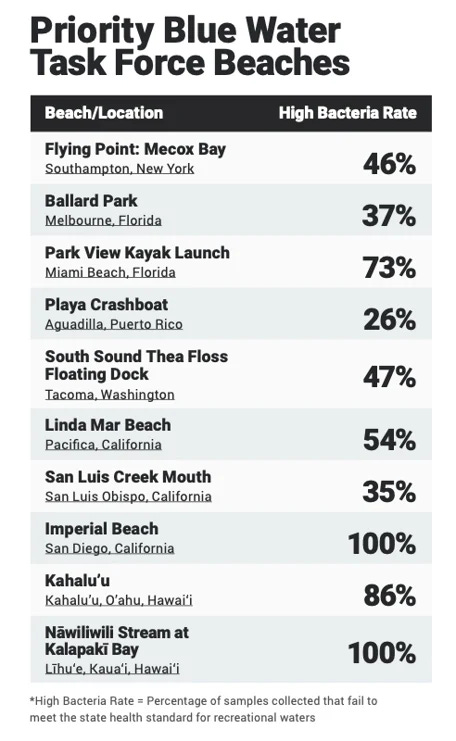The Top 10 Most Polluted Beaches 🌊
Is Everybody Going Surfing... In Water That Could Make Them Sick?!

Ever wonder about water quality at the beach?
More than 100 million people flock to U.S. beaches every year to swim, surf, paddle, and enjoy the sunshine and sand.
As summer begins, let’s take a look at a new report on the state of beaches conducted by Surfrider Foundation, which tested thousands of water samples from coast to coast, as well as in Puerto Rico, Costa Rica, and Canada.
The results are sickening. About 64 percent of the more than 560 sites tested had at least one sample with unsafe bacteria levels, exceeding state health standards.
Each location was tested multiple times, according to Mara Dias, the foundation’s senior manager for the Clean Water Initiative.
Surfrider Foundation chapters broke all previous testing records with more labs, more sampling sites, and more water quality tests performed than ever before. The data reveals chronic pollution problems.
Topping the list is Imperial Beach in San Diego, where every sample collected turned up bacteria counts that exceeded the state’s health standard for recreational waters. In fact, the area has been plagued with severe pollution for decades.
Imperial Beach sits at the southernmost tip of San Diego County near the border with Mexico and has long been saturated with pollution, mostly from cross-border sewage and a failing treatment plant leaking untreated water into the Tijuana River Estuary.
“Every day, millions of gallons of contaminated water carrying stormwater runoff, raw sewage, harmful chemicals, and trash traverse the U.S.-Mexico border through the Tijuana River Watershed and flow out into the Pacific Ocean in Imperial Beach,” according to the report.
You may remember that the Tijuana River was just named one of the top ten most endangered rivers in the United States by American Rivers.
Paloma Aguirre, mayor of Imperial Beach, has requested a Federal Emergency Declaration for the Tijuana River Valley and the shoreline of Imperial Beach.
“The community of Imperial Beach is bearing the brunt of this environmental disaster,” she wrote in a recent letter to the White House. “Pollution in the Tijuana River remains the most urgent environmental justice issue in San Diego County…. An entire generation of children is growing up in South San Diego County, having only experienced polluted beaches.”
Research from the Scripps Institute of Oceanography, with funding from the Environmental Protection Agency (EPA), attributes 34,000 illnesses in calendar year 2017 to water quality pollution along the Imperial Beach coastline.
And this beach in San Diego is not alone.
For example, Park View Kayak Launch in Miami, Florida, Ballard Park in Melbourne, Florida, and Playa Crashboat in Aguadilla, Puerto Rico, are all popular spots for families to enjoy a fun day at the beach or in the water, but they are also all affected by old, failing sewage infrastructure.
Three of the top 10 most polluted locations mentioned in the report are located in California. At Linda Mar Beach in Pacifica, more than half the samples had unsafe bacteria levels, as well as the mouth of the San Luis Obispo Creek in San Luis Obispo, where 35 percent of the samples had unsafe levels.
Nearly 10 trillion gallons of untreated stormwater runoff flow into U.S. waterways every year, carrying a cocktail of pollutants including road dust, oil, animal waste, fertilizers, and other chemicals, according to the report. Years of neglect and underfunding have also left America’s outdated wastewater infrastructure in disrepair.
Stormwater can wash chemicals and other pollutants from streets and lawns into local waterways and down to the beach.
In Hawai‘i, Surfrider’s Blue Water Task Force (BWTF) programs on O‘ahu, Kaua‘i, and Maui have long measured high bacteria levels where people enjoy recreational activities in the water, but many of these sites are not tested by the beach program run by the State Department of Health (DOH).
At each of these beaches featured in the report, local chapters of a BWTF program are working to build awareness of the pollution problems and to provide their communities with critical public health information. The primary objective is to locate and address sources of pollution to restore clean water locally.
Natural waterways should not make people sick. We all need access to clean water for drinking but also to surf, swim, and play in.
Want to know more about water quality advisories that might impact your local beach? Check out: Beach Water Quality Monitoring Programs in Coastal States.



